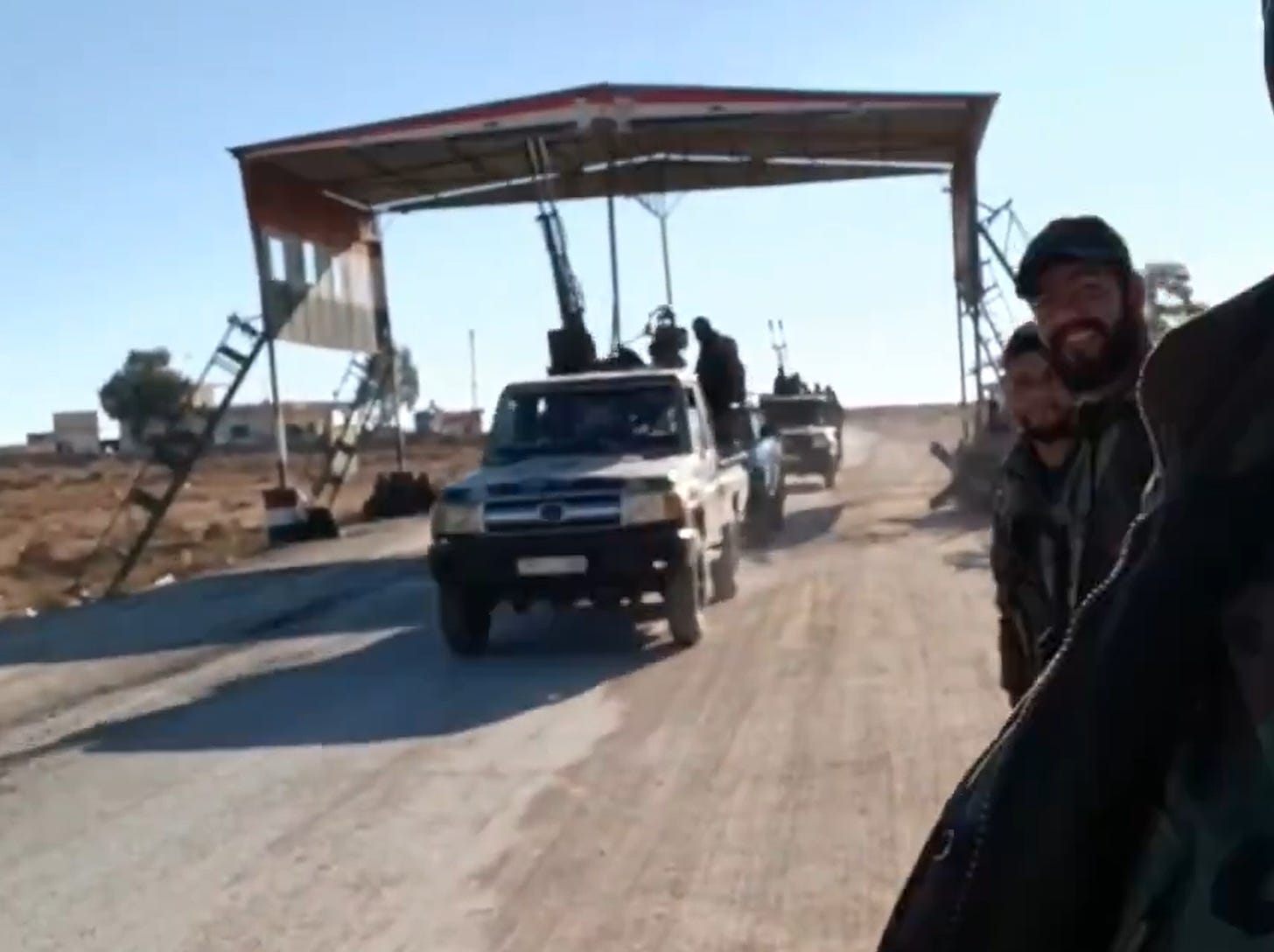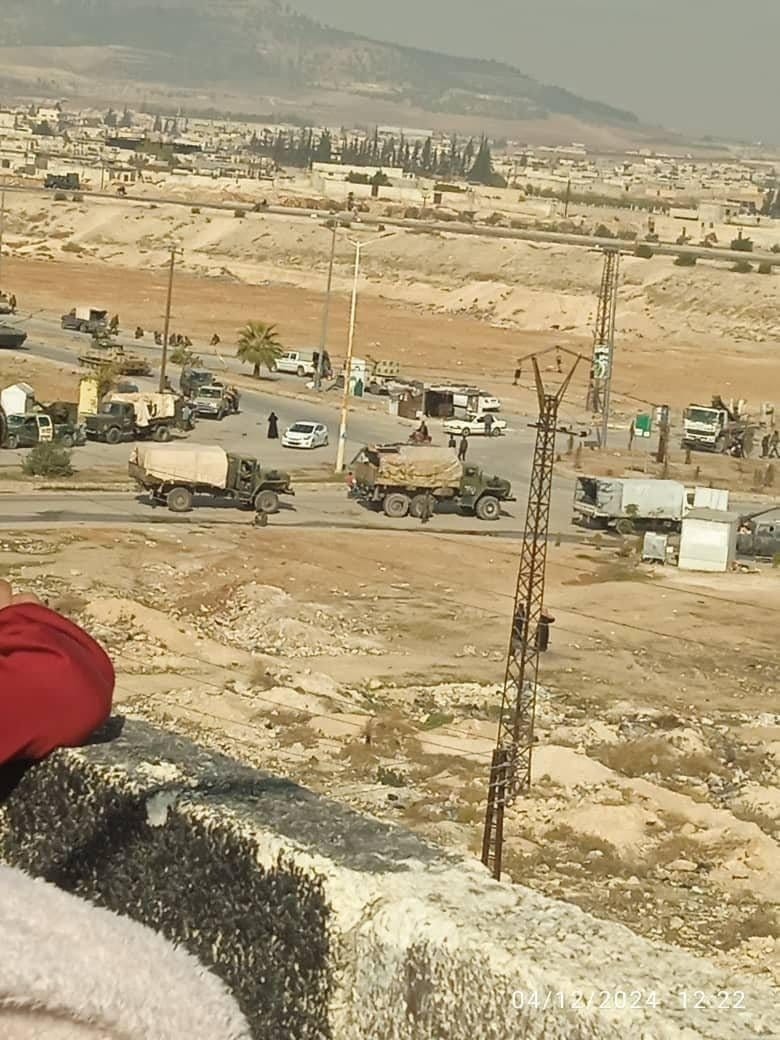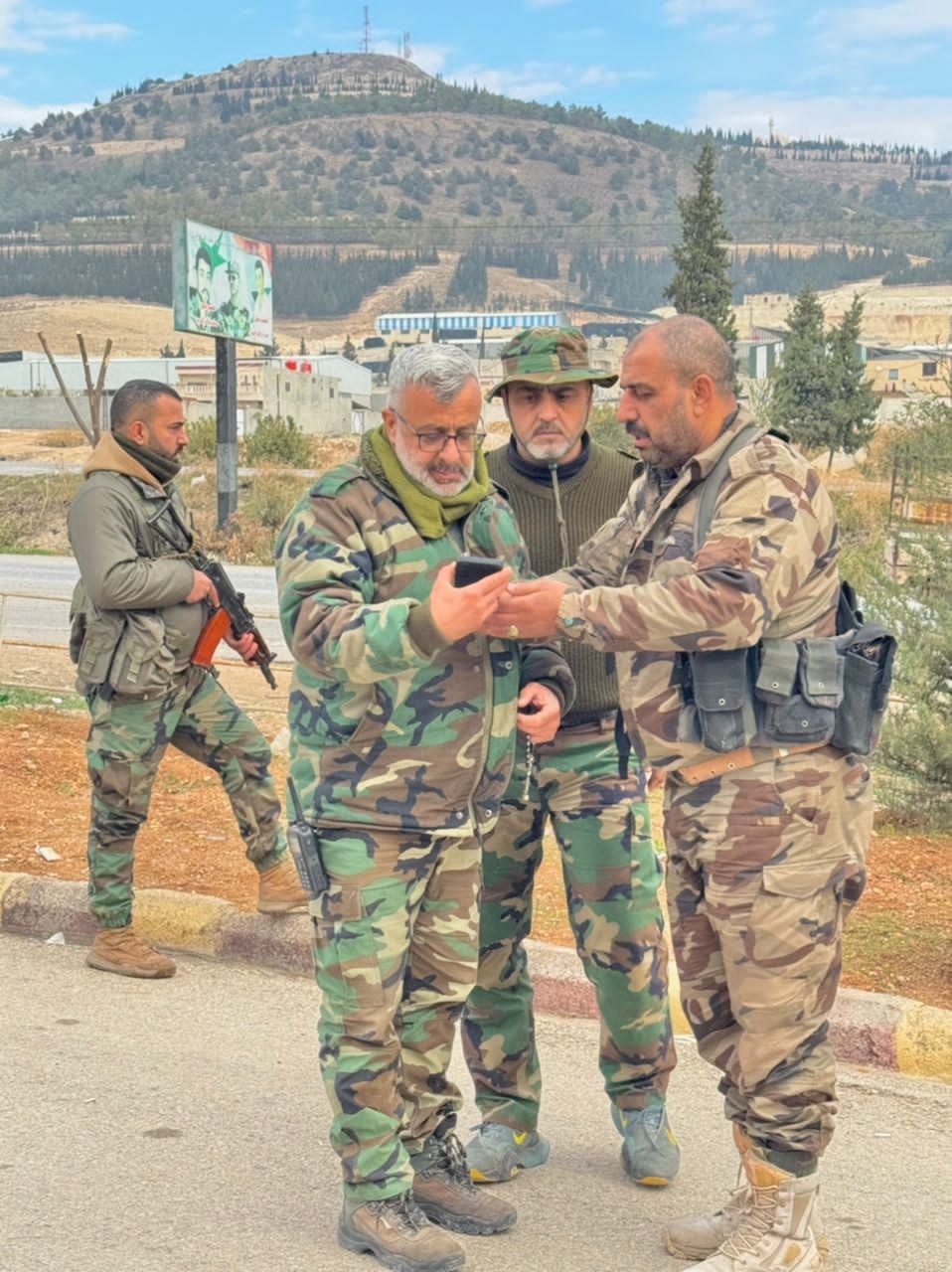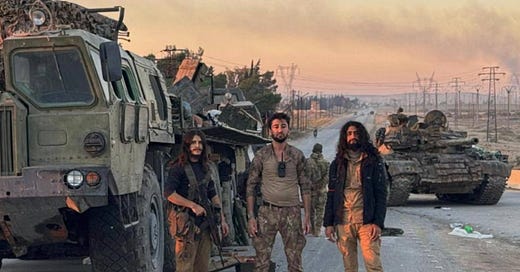Those Who Fought and Those Who Fled
An initial examination of what happened to the regime forces deployed in the north
The Syrian opposition’s northern advance has now been joined by locals in southern Syria. Over the past 24 hours, former opposition fighters and anti-regime locals in Dara’a, Suwayda, and the Damascus countryside have rapidly expelled regime forces from their areas. The entire governorates of Dara’a and Suwayda are now free, while the army has abandoned most of the eastern Damascus countryside and withdrawn from many of the city’s outlying neighborhoods. In the country’s east, the army began abandoning its positions in rural Homs, Raqqa, and Deir Ez Zor on December 5, with the Syrian Democratic Forces and local tribesmen taking over Deir Ez Zor on December 6. Homs city seemed to be the only front where any real resistance had been established, but it too was liberated after the second night of clashes.
It remains unclear where the bulk of the army was in all of this. The army units stationed in southern and eastern Syria have been deployed there for many years, and so they were never a factor in reinforcing the northern front. More than 500 soldiers and officers from southern units defected on December 6, including the surrender of all 15th Division bases in Suwayda following brief clashes. These southern units account for the bulk of the 5th, 7th, and 9th Divisions of the regular army, as well as the 15th Special Forces Division and parts of the 14th Special Forces Division. In eastern Syria, the regime had maintained the bulk of the 17th Division, the 5th Corps’ 7th Brigade, and parts of the 18th Division and Republican Guard.
Yet this accounts for less than half of the regular army, let alone the ‘core’ units of the 4th Division, Republican Guard, and 25th Division. As previously covered, a slate of internal issues has plagued the SAA, resulting in severely weakened force that could not stand up to a unified opposition front on its own. Yet despite these issues, these units did exist one week ago. Which have seen combat, where have the others gone, and what does this say about the military high command’s response to the opposition offensive?
Information has gradually come out regarding what units fought in Aleppo, Idlib, and Hama between November 27 and December 5. This information is certainly not exhaustive but it can help provide the first assessment of how the regime deployed - or didn’t - its forces during that first week. All of this information is based on videos on pro-regime social media showing the movement of specific units and reports linking regime ‘martyrs’ to specific units.
Aleppo
The Aleppo axis was largely manned by the 30th Republican Guard Division, whose forces stretched from Afrin to Tadeh and down to Saraqib in Idlib. This includes the 102nd Regiment, 107th Regiment, 147th Regiment, and 152nd Regiments in western Aleppo and the 47th Regiment in eastern Aleppo. These units took significant casualties in the first days of the fighting, and likely withdrew to Safira, then took the Khanasir-Ithriya route to Hama as the countryside fell (an SAA complaint page wrote on November 27 that “three regiments of the division fell in less than an hour” with more than 70 soldiers killed and the battalion commanders abandoning their units). Joining the division was at least one battalion of the 105th Brigade (long seen as the core of the Republican Guard and protector of Damascus), and remnants of the 47th Special Forces Regiment at their base outside Atarib. A group of officers from the brigade, including a major, were killed in west Aleppo on the first day of the battle, either sent as some of the earliest reinforcements or already stationed on the front, and a 105th Brigade battalion commander was killed on the Aleppo city front on November 29.
Reinforcements were quickly deployed from the nearby 25th Division regiment and the 3rd Division, both based in Tel Rifaat and around al-Bab. The 25th Division’s 78th Regiment had actually been the main regime force sent to the north Aleppo front in October, when rumors of an opposition offensive first emerged. The core units from this regiment - the Zulfiqar Regiment, one of the original Tiger Forces militias - were fighting on the Bashnatrah axis by the afternoon of the 27th. This suggests that, while the 30th Division was collapsing, either the Russian or Syrian commanders of the 25th Division were at least reacting quickly in the first hours of the attack. Units of the 3rd Division, however, appear to have not been sent until the 28th or 29th, when additional 25th Division and Special Forces units (reportedly from the 14th and 15th Divisions) arrived to reinforce the west Aleppo suburbs. Major General Suhail Hassan, the former commander of the 25th Division and recently appointed commander of Syria’s Special Forces, was pictured with newly arrived armor at the Hamadaniyah Roundabout on the evening of the 28th. It is likely that Hassan and these units arrived from either southern Raqqa or southeast Aleppo.
November 28 also marked the first concrete evidence of the widespread deployment of Syrian Shia militias backed by Hezbollah and Iran. At least 14 fighters from the nearby Nubl and Zahara towns were reported killed in fighting in the Muhandiseen area (south axis), Yaqid al-Adas (central axis), and Sheikh Aqil (north axis). While it is possible they had already deployed the day before, the sudden appearance of so many death notices linked to the main areas of fighting that day suggests they were not sent to the front until 24 hours after the battle began. Other Iran-backed local militias like the Local Defense Forces seem to have mobilized late on the 28th, but were simply kept in their neighborhoods and towns far from west Aleppo. By November 30 at least some units from the Russian-backed 5th Corps had also deployed - likely to southern axis of the west Aleppo front - where they took casualties.
Despite the rapid deployment of the nearby 78th Regiment, the fact that it took more than a day for additional units to arrive - by which point the opposition had already reached the city outskirts - suggests to a failure by the Syrian and Russian high command to properly assess the fragility of their position. It is also unclear what happened to the other SAA units deployed in north Aleppo. The 1st Division has maintained a significant (theoretically brigade-sized) deployment around Manbij and al-Bab, but these units seemingly remained stationary during the fight for Aleppo until the mass regime withdraw from the north. There is no evidence that any 1st Division unit fought in Hama, rather they entire division was likely pulled back to its bases around Damascus in the first days of December. The 106th Republican Guard Brigade had maintained at least some units around Zerbeh, on the M5 south of Aleppo, but it is unclear how much these units fought given how quickly this axis collapsed on November 28.
It is worth noting that one pro-regime commentator wrote on Facebook in recent days a scathing reproach of the army’s conduct, claiming that the bulk of the 105th Brigade had been deployed to the Aleppo front for more than a year to prevent this very attack (videos of this deployment were published in late June 2023). The author also claims that more than 2,800 soldiers had surrendered to the opposition on the first day of Aleppo’s liberation, suggesting that a huge number of the soldiers stationed here had simply fled and hid in the city until the fighting was over. He accuses the intelligence officers of leaving the city immediately upon the first day’s attack, appointing low ranking men to take command in their stead, while the Russian air force did not begin bombing until the opposition had entered the city itself and only then struck Christian neighborhoods and civilians.
More than 180 soldiers were confirmed killed on the Aleppo front between November 27 and November 30, among them:
Major Generals: 1 (from the al-Assad Military Engineering Academy)
Brigadier Generals: 2 (commander of Aleppo Military Intelligence Branch and the Security Officer of the al-Assad Military Engineering Academy)
Colonels: 4
Lt Colonels: 2 (including 105th Brigade battalion commander)
Majors: 5 (including from the 105th Brigade, Criminal Security, and 46th Regiment)
The demographics of the documented dead suggest that most came from the Republican Guard and 25th Division. At least 65% were from the core regime recruitment areas of Homs, Hama, Tartous and Latakia, all areas that feed heavily into these units versus the more Sunni-dominated recruitment for the regular army units that had been present on the front. So while it cannot be said for certain that the SAA did not fight in this battle, there remains no concrete evidence (yet) that those brigades were redeployed to the Aleppo axis.

Idlib
The opposition opened the eastern Idlib front on on the evening of the 28th, diverting some units from western Aleppo to support a new push on the key city of Saraqib. These forces quickly advanced on three towns along the frontline, closing the gap and effectively cutting off the M5 south of the city. Over the next 24 hours, attackers faced hard resistance in Saraqib, with multiple failed storming attempts. But with the advances continuing north of the city and the highway remaining cut to the south, it was only a matter of time. Late in the afternoon of the 29th, opposition forces entered Saraqib and began clearly the remaining defenders, with most regime forces having been ordered to withdraw to Abu Dhuhur Airport, according to one regime source.
Saraqib had been the linchpin of the regime’s eastern Idlib defensives, with Abu Dhuhur the theoretical second line of defense. The 30th Division’s 124th Brigade was headquartered in the old military air base while Saraqib hosted a plethora of 25th Division units, the 5th Corps’ 1st Regiment and 3rd Brigade, and a number of Iran-backed militias. The 11th Division’s 60th and 67th Brigades had long held positions around Jowbas, just south of Saraqib. Elsewhere in east and south Idlib were stationed parts of:
6th Division’s 76th Brigade
7th Division’s 90th Brigade
11th Division’s 135th Artillery Regiment
4th Corps artillery and members of its 6th Division
5th Corps’ 1st and 6th Brigades
15th Division’s 44th Regiment, 531 Battalion,
Republican Guard’s 400th Battalion
The fall of Saraqib seemed to signal a broader retreat from Idlib, which may have turned into a more chaotic route. Local opposition forces stationed on the frontline reportedly advanced on their own initiative, suddenly expanding the previously narrow axis around Saraqib into a governorate-wide advance. Only sporadic deaths have been reported for both sides in these areas. Abu Dhuhur - a potential fallback position for regime forces - was abandoned without a fight. The southern Idlib countryside was likewise quickly abandoned, with a few opposition and regime deaths reported in towns like Maarat al-Numan and Khan Sheikhoun, but these likely occurred when advancing forces overlapped with still-retreating regime units.
Overall, the Idlib route took less than a day. The vast majority of the regime’s deployed units here neither opened their own front during the first days of fighting in west Aleppo nor did they make any real attempt to create a defensive line north of Hama city. One brigadier general was killed during the retreat on November 30, perhaps indicating the degree of the chaos that had engulfed regime units.
Hama
The retreat to Hama City saw the first re-organization of regime units as well as real reinforcements being sent to the north. Fleeing units had either grouped in Ithriya - far to the east - or in the city itself, and these units would now mix with local militias to form a long defensive line stretching from Qalaat al-Mudiq in the northwest to Ithriya. As the heart of the old Tiger Forces militia network, this new line was naturally heavily saturated by 25th Division units (both original Tiger groups that had merged into the division as well as rural eastern Hama militias that had more recently been incorporated) as well as by the 5th Corps’ 2nd Brigade, which has conducted anti-ISIS operations across eastern Hama routinely over the past two years. The 5th Corps maintained a large headquarters at Maar Shahour, the key town at the northeastern entrance to Hama City, the 25th Division headquarters just east of that, and the 8th Division’s 47th Brigade based just south of the city. The northwestern countryside of the province was secured by nearly the entirety of the 4th Corps, whos division and brigades stretched from the Sahel al-Ghab through Latakia to the Turkish border, as well as elements of the 4th Division’s 555th Regiment around Kernaz. The Republican Guard had also recently taken over the infamous Joureen Camp to the west.

However none of these northwest-based units appear to have fought much during the campaign, and certainly none launched their own attacks on opposition lines to try and relieve pressure elsewhere. Some 5th Corps fighters and 25th Division units held the Qalaat al-Mudiq axis where they managed to repel multiple opposition attacks for several days, but the bulk of the western front was manned by local militias affiliated with the 25th Division and supported by small amounts of armor, remnants from the fleeing northern units. Confirmed redeployed northern units include the 15th Special Forces Division (sent to Jabal Zein al-Abidin) and the 152nd Infantry Regiment of the Republican Guard. It is unclear what happened to the rest of the retreating units, but likely at least some of their heavy equipment was divvied up to support local militias.

What reinforcements did arrive deployed in Hama city itself and the key Jabal Zain al-Abideen. The 4th Division’s 42nd Brigade arrived beginning on December 1, bringing with it the infantry of the Ghaith Forces and the heavy rocket “Golan” launchers that it have become infamous for (convoys of the Ghaith Forces were filmed leaving Damascus late on the night of December 28 for Aleppo, but it is unclear if they ever moved past Hama). These units deployed on and around the mountain, where they would lose multiple fighters and at least one unit commander was injured. Alongside them deployed some infantry from the Republican Guard-backed Popular Defense Forces which had been sent from northern Damascus, under the command of a northern Damascus sector commander. In the last 48 hours of the battle, as opposition forces began making rapid gains northwest and northeast of the city, Shia militia fighters likely from Syrian Hezbollah were deployed, with at least five dying during the storming of Hama on December 5.

One of the stranger deployments of the battle, and a sign of how bad the situation had become, was the plethora of Military Intelligence branches that fought across the north Hama front during the second half of the battle. At least branches reported deaths between December 3 and December 4, including:
Hama Branch
Idlib Branch
Branch 227
Palestine Branch
Deir Ez Zor Branch, Mayadeen Department
The timing of the deaths from these units suggests they were sent as a last ditch effort to hold the city as the northern lines collapsed, which begs again begs the question: where was the rest of the army.
More than 130 soldiers were confirmed killed in Hama between December 1 and December 5, among them:
Brigadier Generals: 4 (including the head of the Hama Military Intelligence Branch, commander of the 152nd Regiment, and PDF sector commander and head of the Jabal Zein al-Abidin defense)
Colonels: 4 (including a senior officer of the Salamiyah National Defense Forces)
Lt Colonels: 4 (including a battalion commander of the 47th Brigade, and the commander of the Mayaden Department of the Deir Ez Zir Military intelligence Branch)
Majors: 4
Few answered questions
This preliminary data paints a more complex picture than one of simple complete collapse of the armed forces. There is clear evidence of attempts made at reinforcing frontlines during the west Aleppo battle and the Hama battle, while also strong evidence of a complete collapse of the chain of command once the opposition breached Aleppo city and the Idlib countryside. However, no apparent attempt was made to move any SAA units not already in the north to these fronts, while the SAA command also refused to open any new axes along the Idlib frontline with any of the forces already stationed there. Reinforcements seem to have purely come from militias and core “elite” units. This may hint at deep paranoia by the Ministry of Defense over sending more heavily Sunni and conscript units to a rapidly collapsing front, preferring instead to hold them in bases around Damascus as a final line of defense (though that does not seem to be working as of late on December 7).
Regardless of the answer to what happened to the army, Syria appears to be on the brink of freedom. These battles and questions will soon become a matter of historical research while Syrian civil society and armed groups begin the complex task of forming a new country, piecing together the remnants of a society shattered by decades of regime brutality.




